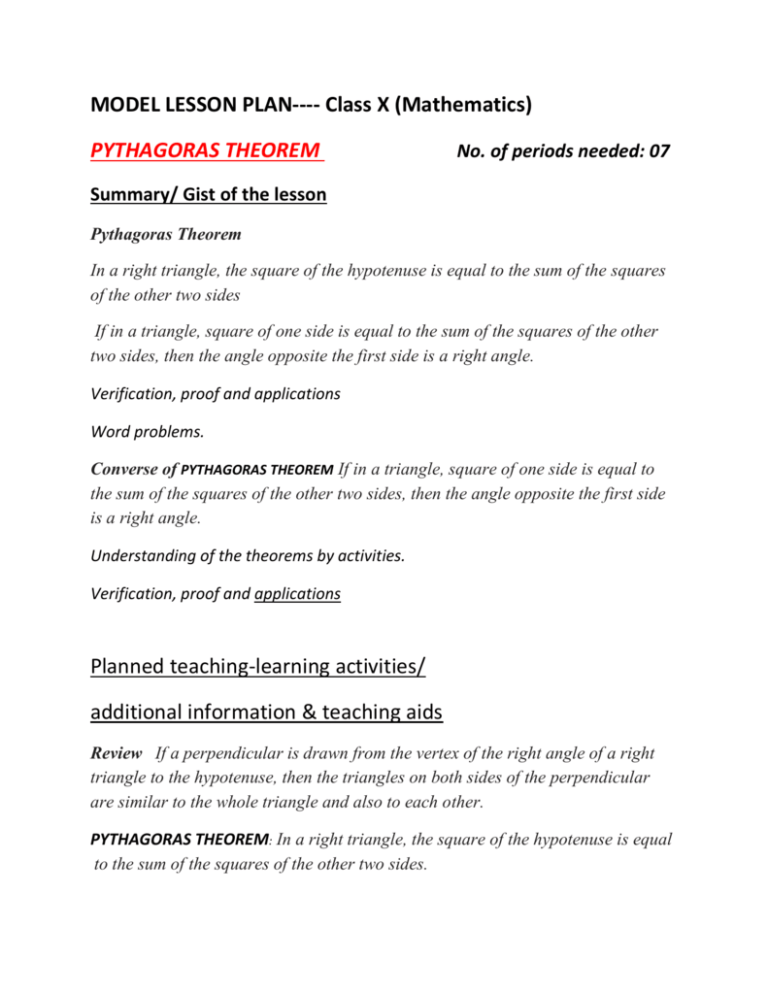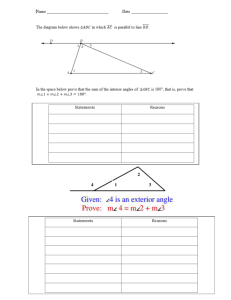If in a triangle, square of one side is equal to the sum of the - e-CTLT
advertisement

MODEL LESSON PLAN---- Class X (Mathematics) PYTHAGORAS THEOREM No. of periods needed: 07 Summary/ Gist of the lesson Pythagoras Theorem In a right triangle, the square of the hypotenuse is equal to the sum of the squares of the other two sides If in a triangle, square of one side is equal to the sum of the squares of the other two sides, then the angle opposite the first side is a right angle. Verification, proof and applications Word problems. Converse of PYTHAGORAS THEOREM If in a triangle, square of one side is equal to the sum of the squares of the other two sides, then the angle opposite the first side is a right angle. Understanding of the theorems by activities. Verification, proof and applications Planned teaching-learning activities/ additional information & teaching aids Review If a perpendicular is drawn from the vertex of the right angle of a right triangle to the hypotenuse, then the triangles on both sides of the perpendicular are similar to the whole triangle and also to each other. PYTHAGORAS THEOREM: In a right triangle, the square of the hypotenuse is equal to the sum of the squares of the other two sides. Verification of the theorem by different activities.1)Tile diagram 2) Paper cutting & pasting activities. 1) 2) 3) 4) 5) Converse of PYTHAGORAS THEOREM If in a triangle, square of one side is equal to the sum of the squares of the other two sides, then the angle opposite the first side is a right angle. Understanding of the theorems by activities. Verification, proof and applications Representation of irrational numbers on number line .√2,√3,√5 etc ADDITIONAL INFORMATION: 1) A proof is credited to the 12th century Hindu mathematician Bhaskara (Bhaskara II): Here we add the two identities c² = (a b)² + 4·ab/2 and c² = (a + b)² - 4·ab/2 which gives 2c² = 2a² + 2b². 2) Proof, discovered by President J. A. Garfield in 1876 [Pappas], is a variation on the previous one. But this time we draw no squares at all. The key now is the formula for the area of a trapezoid half sum of the bases times the altitude -(a + b)/2·(a + b). Looking at the picture another way, this also can be computed as the sum of areas of the three triangles ab/2 + ab/2 = c·c/2. As before, simplifications yield a² + b² = c². Two copies of the same trapezoid can be combined in two ways by attaching them along the slanted side of the trapezoid. 3) FA2 ACTIVITIES 1) Representation of irrational numbers on number line .√2,√3,√5 etc 2) Verification of Pythagoras theorem by 1) Tile diagram 2) Paper cutting & pasting methods (any two ) TEACHING AIDS : Geometrical instruments, Paper cut outs of right triangles, coloured paper etc Power point presentation, videos Questions LEVEL 1) Find the missing side lengths. Leave your answers as radicals in simplest form. 2) Find the missing side of each right triangle. Side cis the hypotenuse. Sides A and b are the legs. Leave your answers in simplest radical form. 1) am, c m 2) b cm, c cm 3) State if each triangle is a right triangle. 4) State if the three side lengths form a right triangle. a) b) LEVEL 2) 1) Find the value of the height, h m, in the following diagram at which the tennis ball must be hit so that it will just pass over the net and land 6 metres away from the base of the net. 2) What is the length of the diagonal of a rectangle of length 3 and width 2? 3) Town B is 8 miles north and 17 miles east of town A. How far are the two towns apart? 4) A 3m ladder stands on horizontal ground and reaches 2.8 m up a vertical wall. How far is the foot of the ladder from the base of the wall? 5) What is the length of the side x? 6) Does a triangle of sides 8, 15, 16 units have a Right Angle? 7) Find the height to which the ladder reaches the wall. LEVEL 3 1) Sides AB and BC and median AD of a ∆ ABC are respectively proportional to sides PQ and QR and median PM of ∆PQR Show that ∆ABC ~ ∆PQR. 2) BL and CM are medians of a triangle ABC right angled at A. Prove that 4 (BL2 + CM2) = 5 BC2. 3) Prove that the sum of the squares of the sides of a rhombus is equal to the sum of the squares of its diagonals. 4) In an equilateral triangle ABC, D is a point on side BC such that BD =1/3BC. Prove that 9 AD2 = 7 AB2. PROJECT: 1) Represent irrational numbers of the form √n like .√2,√3,√5… using the 𝑛+1 𝑛−1 relation √n = √ ( )² - ( )² 2 2 2) Prepare water proof of Pythagoras theorem model. 3) Prepare tile diagram to verify Pythagoras theorem






